Track-to-Track Association for Intelligent Vehicles by Preserving Local Track Geometry
Abstract
1. Introduction
- The mathematical formulation for T2TASB is presented. Moreover, the local track geometry with k-connected neighborhood is derived to improve the robustness and accuracy of T2TASB. The proposed method extends the CPD method by considering the geometric relationship between neighboring tracks.
- An EM algorithm is proposed for T2TASB. The optimal T2TASB correspondence matrix and transformation function between local tracks are estimated simultaneously.
- The performance of the proposed method is validated by the experiments and computer simulations using the KITTI dataset.
2. A New Method for T2TASB
3. EM Solution for the Proposed Method
- 1).
- E-step:
- 2).
- M-step: ,
3.1. E-Step
3.2. M-Step
| Algorithm 1 Proposed LTGP method for T2TASB |
| Require: |
| Local tracks and , parameters w, , , , M. |
| Ensure: |
| Transformed local track from sensor 2 is . |
| Association matrix for T2TASB is as in (3.2). |
4. Computer Simulations
5. Experiments on KITTI Dataset
6. Conclusions
Author Contributions
Funding
Acknowledgments
Conflicts of Interest
Appendix A. The Relationship of Two Local Tracks
Abbreviations
| T2TA | Track-to-track association |
| T2TASB | Track-to-track association with sensor bias |
| LTGP | Local track geometry preservation |
| GMM | Gaussian mixture model |
| EM | Expectation-maximization |
| NN | Nearest neighbor |
| GNN | Global nearest neighbor |
| ML | Maximum likelihood |
| OSPA | Optimal sub-pattern assignment |
| CPD | Coherent point drift |
| Local tracks from sensor s at time k | |
| K | Total number of discrete time steps |
| Number of tracks at time k by sensor s | |
| t-th data from sensor 1 at time k | |
| Centroid of the l-th component from sensor 2 at time k | |
| Gaussian distribution | |
| Equal isotropic covariance at time k | |
| f | Nonrigid transformation |
| Identity matrix | |
| D | Size of a local track vector |
| Membership probability of t-th row and l-th column element in at time k | |
| Membership probability matrix at time k | |
| Indicator matrix | |
| a binary vector for at time k | |
| t-th row and l-th column element in at time k | |
| an dimensional weight matrix of the Gaussian kernel | |
| an Gaussian kernel matrix | |
| an i-th row and j-th column element in | |
| the width parameter in the smoothing Gaussian filter | |
| Trace of a matrix | |
| weighted matrix | |
| a l-th row and j-th column element in | |
| i-th row of | |
| Trade-off parameter controlling between Q and | |
| an matrix | |
| Cost matrix of T2TASB at time k as an matrix | |
| x-axis and y-axis positions of target | |
| x-axis and y-axis positions of target |
References
- Zhu, H.; Yuen, K.; Mihaylova, L.; Leung, H. Overview of Environment Perception for Intelligent Vehicles. IEEE Trans. Intell. Transp. Syst. 2017, 18, 2584–2601. [Google Scholar] [CrossRef]
- Li, Y.; Chen, W.; Peeta, S.; Wang, Y. Platoon Control of Connected Multi-Vehicle Systems Under V2X Communications: Design and Experiments. IEEE Trans. Intell. Transp. Syst. 2019. [Google Scholar] [CrossRef]
- Zhu, H.; Zou, K.; Li, Y.; Cen, M.; Mihaylova, L. Robust Non-Rigid Feature Matching for Image Registration Using Geometry Preserving. Sensors 2019, 19, 2729. [Google Scholar] [CrossRef] [PubMed]
- Zhu, H.; Guo, B.; Zou, K.; Li, Y.; Yuen, K.; Mihaylova, L. A Review of Point Set Registration: From Pairwise Registration to Groupwise Registration. Sensors 2019, 19, 1191. [Google Scholar] [CrossRef] [PubMed]
- Li, Y.; Tang, C.; Peeta, S.; Wang, Y. Integral-Sliding-Mode Braking Control for a Connected Vehicle Platoon: Theory and Application. IEEE Trans. Ind. Electron. 2019, 66, 4618–4628. [Google Scholar] [CrossRef]
- Li, Y.; Tang, C.; Peeta, S.; Wang, Y. Nonlinear Consensus-Based Connected Vehicle Platoon Control Incorporating Car-Following Interactions and Heterogeneous Time Delays. IEEE Trans. Intell. Transp. Syst. 2019, 20, 2209–2219. [Google Scholar] [CrossRef]
- Kim, D.; Jo, K.; Lee, M.; Sunwoo, M. L-Shape Model Switching-Based Precise Motion Tracking of Moving Vehicles Using Laser Scanners. IEEE Trans. Intell. Transp. Syst. 2018, 19, 598–612. [Google Scholar] [CrossRef]
- Ji, X.; Zhang, G.; Chen, X.; Guo, Q. Multi-Perspective Tracking for Intelligent Vehicle. IEEE Trans. Intell. Transp. Syst. 2018, 19, 518–529. [Google Scholar] [CrossRef]
- Zhang, Y.; Song, B.; Du, X.; Guizani, M. Vehicle Tracking Using Surveillance With Multimodal Data Fusion. IEEE Trans. Intell. Transp. Syst. 2018, 19, 2353–2361. [Google Scholar] [CrossRef]
- Alessandretti, G.; Broggi, A.; Cerri, P. Vehicle and Guard Rail Detection Using Radar and Vision Data Fusion. IEEE Trans. Intell. Transp. Syst. 2007, 8, 95–105. [Google Scholar] [CrossRef]
- Singer, R.; Kanyuck, A. Computer control of multiple site track correlation. Automatica 1971, 7, 455–463. [Google Scholar] [CrossRef]
- Sorenson, H.W. An efficient track association algorithm for the multitarget tracking problem. Inf. Sci. 1980, 21, 241–260. [Google Scholar] [CrossRef]
- Bar-Shalom, Y. On the track-to-track correlation problem. IEEE Trans. Autom. Control. 1981, 26, 571–572. [Google Scholar] [CrossRef]
- He, Y.; Zhang, J. New track correlation algorithms in a multisensor data fusion system. IEEE Trans. Aerosp. Electron. Syst. 2006, 42, 1359–1371. [Google Scholar]
- Chong, C.Y.; Mori, S. Metrics for Feature-Aided Track Association. In Proceedings of the 9th International Conference on Information Fusion, Florence, Italy, 10–13 July 2006; pp. 1–8. [Google Scholar]
- Mori, S.; Chang, K.C.; Chong, C.Y. Performance prediction of feature-aided track-to-track association. IEEE Trans. Aerosp. Electron. Syst. 2014, 50, 2593–2603. [Google Scholar] [CrossRef]
- Kaplan, L.M.; Bar-Shalom, Y.; Blair, W.D. Assignment costs for multiple sensor track-to-track association. IEEE Trans. Aerosp. Electron. Syst. 2008, 44, 655–677. [Google Scholar] [CrossRef]
- Kragel, B.; Herman, S.; Roseveare, N. A Comparison of Methods for Estimating Track-to-Track Assignment Probabilities. IEEE Trans. Aerosp. Electron. Syst. 2012, 48, 1870–1888. [Google Scholar] [CrossRef]
- Liu, X.; Yin, H.; Liu, H.Y.; Wu, Z.M. Performance of track-to-track association algorithms based on Mahalanobis distance. Sens. Transducers 2013, 22, 58–65. [Google Scholar]
- Bar-Shalom, Y.; Chen, H. Multisensor track-to-track association for tracks with dependent errors. In Proceedings of the 2004 IEEE Conference on Decision and Control, Nassau, Bahamas, 14–17 December 2004; pp. 2674–2679. [Google Scholar]
- Osbome, R.W.; Bar-Shalom, Y.; Willett, P. Track-to-track association with augmented state. In Proceedings of the 2011 International Conference on Information Fusion, Chicago, IL, USA, 5–8 July 2011; pp. 1–8. [Google Scholar]
- Bar-Shalom, Y.; Chen, H. Track-to-Track Association Using Attributes. J. Adv. Inf. Fusion 2007, 2, 49–59. [Google Scholar]
- Song, T.L.; Musicki, D. Smoothing innovations and data association with IPDA. Automatica 2012, 48, 1324–1329. [Google Scholar] [CrossRef]
- Dencux, T.; Zoghby, N.E.; Cherfaoui, V.; Jouglet, A. Optimal Object Association in the Dempster-Shafer Framework. IEEE Trans. Cybern. 2014, 44, 2521–2531. [Google Scholar]
- Lee, K.H.; Kanzawa, Y.; Derry, M.; Jamesy, M.R. Multi-Target Track-to-Track Fusion Based on Permutation Matrix Track Association. In Proceedings of the 2018 IEEE Conference on Intelligent Vehicles Symposium, Changshu, China, 26–30 July 2018; pp. 465–470. [Google Scholar]
- Zhao, H.; Sha, J.; Zhao, Y.; Xi, J.; Cui, J.; Zha, H.; Shibasaki, R. Detection and Tracking of Moving Objects at Intersections Using a Network of Laser Scanners. IEEE Trans. Intell. Transp. Syst. 2012, 13, 655–670. [Google Scholar] [CrossRef]
- Wang, X.; Xu, L.; Sun, H.; Xin, J.; Zheng, N. On-Road Vehicle Detection and Tracking Using MMW Radar and Monovision Fusion. IEEE Trans. Intell. Transp. Syst. 2016, 17, 2075–2084. [Google Scholar] [CrossRef]
- Jo, K.; Lee, M.; Sunwoo, M. Track Fusion and Behavioral Reasoning for Moving Vehicles Based on Curvilinear Coordinates of Roadway Geometries. IEEE Trans. Intell. Transp. Syst. 2018, 19, 3068–3075. [Google Scholar] [CrossRef]
- Papageorgiou, D.J.; Sergi, J.D. Simultaneous Track-to-Track Association and Bias Removal Using Multistart Local Search. In Proceedings of the IEEE Aerospace Confence, Big Sky, MT, USA, 1–8 March 2008; pp. 1–14. [Google Scholar]
- Okello, N.N.; Challa, S. Joint sensor registration and track-to-track fusion for distributed tracks. IEEE Trans. Aerosp. Electron. Syst. 2004, 40, 808–823. [Google Scholar] [CrossRef]
- Huang, D.; Leung, H.; Bosse, E. A Pseudo-Measurement Approach to Simultaneous Registration and Track Fusion. IEEE Trans. Aerosp. Electron. Syst. 2012, 48, 2315–2331. [Google Scholar] [CrossRef]
- Zhu, H.; Leung, H.; Yuen, K.V. A joint data association, registration, and fusion approach for distributed tracking. Inf. Sci. 2015, 324, 186–196. [Google Scholar] [CrossRef]
- Tian, W.; Wang, Y.; Shan, X.; Yang, J. Track-to-Track Association for Biased Data Based on the Reference Topology Feature. IEEE Signal Process. Lett. 2014, 21, 449–453. [Google Scholar] [CrossRef]
- Tian, W. Reference pattern-based track-to-track association with biased data. IEEE Trans. Aerosp. Electron. Syst. 2016, 52, 501–512. [Google Scholar] [CrossRef]
- Zhu, H.; Wang, M.; Yuen, K.V.; Leung, H. Track-to-Track Association by Coherent Point Drift. IEEE Signal Process. Lett. 2017, 24, 643–647. [Google Scholar] [CrossRef]
- Wan, Y.; Puig, V.; Ocampo-Martinez, C.; Wang, Y.; Harinath, E.; Braatz, R.D. Fault detection for uncertain LPV systems using probabilistic set-membership parity relation. J. Process. Control. 2020, 87, 27–36. [Google Scholar] [CrossRef]
- Myronenko, A.; Song, X. Point Set Registration: Coherent Point Drift. IEEE Trans. Pattern Anal. Mach. Intell. 2010, 32, 2262–2275. [Google Scholar] [CrossRef] [PubMed]
- Singer, R.A.; Stein, J.J. An optimal tracking filter for processing sensor data of imprecisely determined origin in surveillance systems. In Proceedings of the 1971 IEEE Conference on Decision and Control, Miami Beach, FL, USA, 15–17 December 1971; pp. 171–175. [Google Scholar]
- Kuhn, H.W. The Hungarian Method for the Assignment Problem. Nav. Res. Logist. 1995, 2, 83–97. [Google Scholar] [CrossRef]
- Bar-Shalom, Y.; Li, X.; Kirubarajan, T. Estimation, Tracking and Navigation: Theory, Algorithms and Software; John Wiley & Sons: New York, NY, USA, 2001. [Google Scholar]
- Bentley, J.L. Multidimensional Binary Search Trees Used for Associative Searching. Commun. ACM 1975, 18, 509–517. [Google Scholar] [CrossRef]
- Zhu, H.; Leung, H.; He, Z. State Estimation in Unknown Non-Gaussian Measurement Noise using Variational Bayesian Technique. IEEE Trans. Aerosp. Electron. Syst. 2013, 49, 2601–2614. [Google Scholar] [CrossRef]
- Geiger, A. Probabilistic Models for 3D Urban Scene Understanding from Movable Platforms. Ph.D. Thesis, University of Tübingen, Tübingen, Germany, 2013. [Google Scholar]
- Felzenszwalb, P.F.; Girshick, R.B.; McAllester, D.; Ramanan, D. Object Detection with Discriminatively Trained Part-Based Models. IEEE Trans. Pattern Anal. Mach. Intell. 2010, 32, 1627–1645. [Google Scholar] [CrossRef] [PubMed]
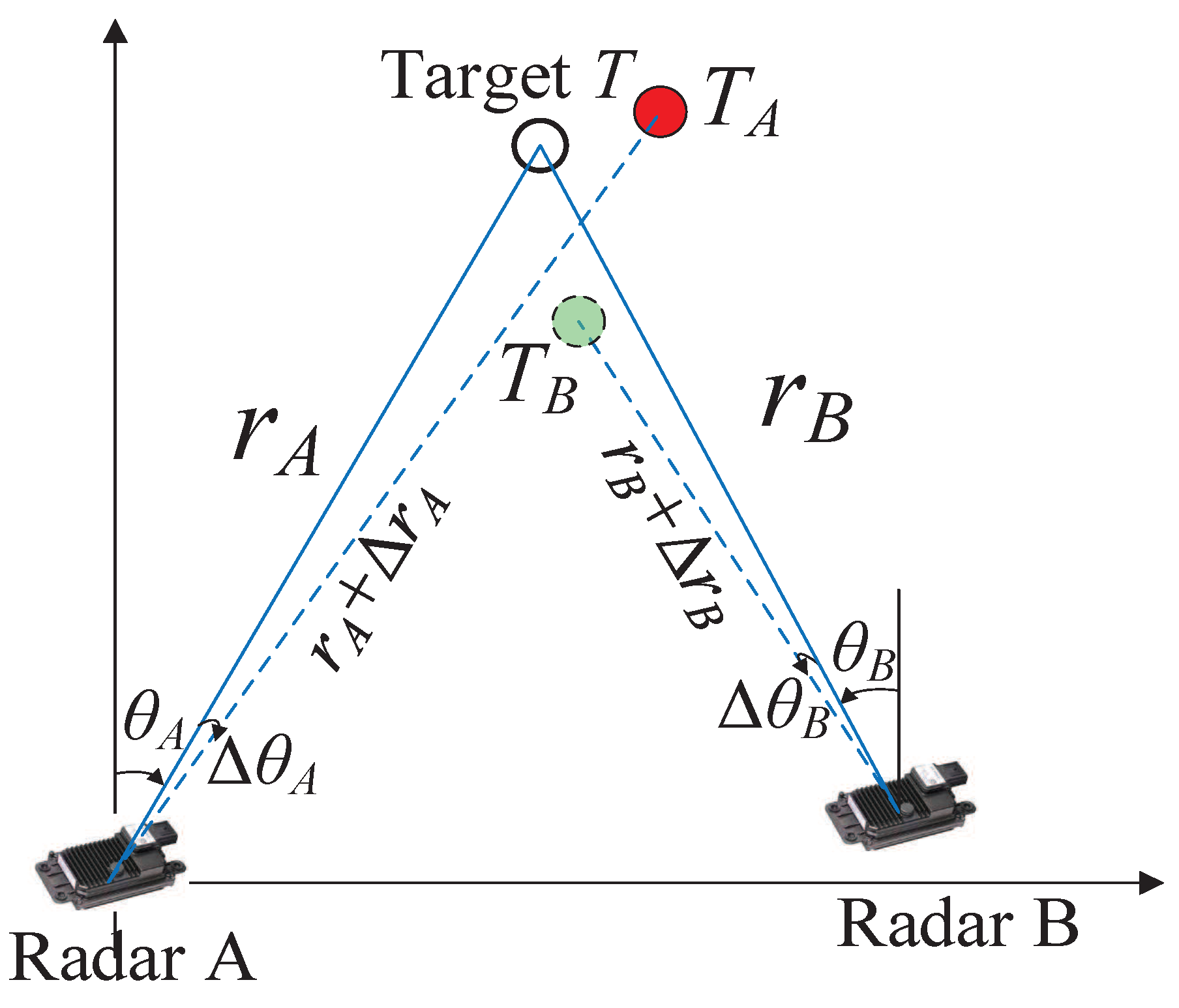
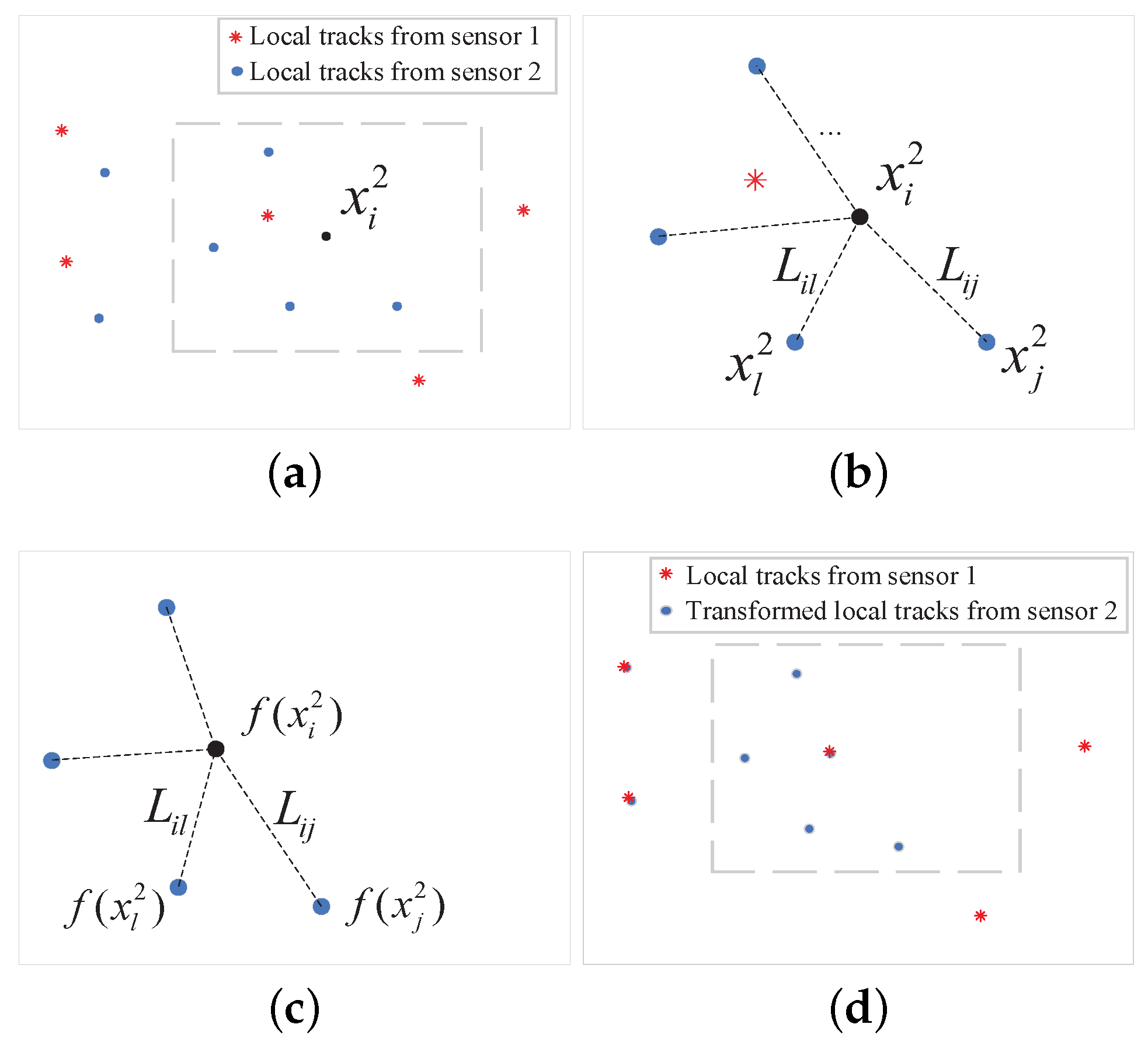
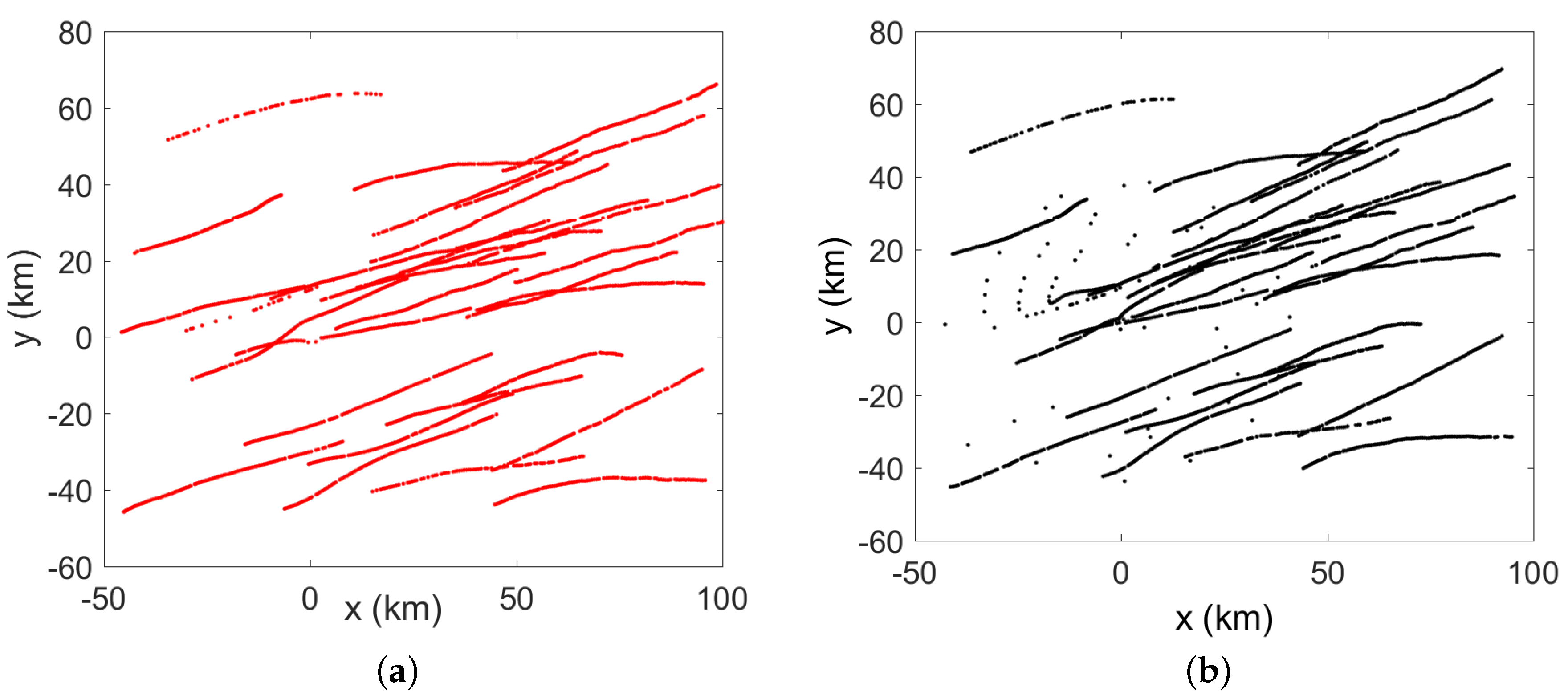
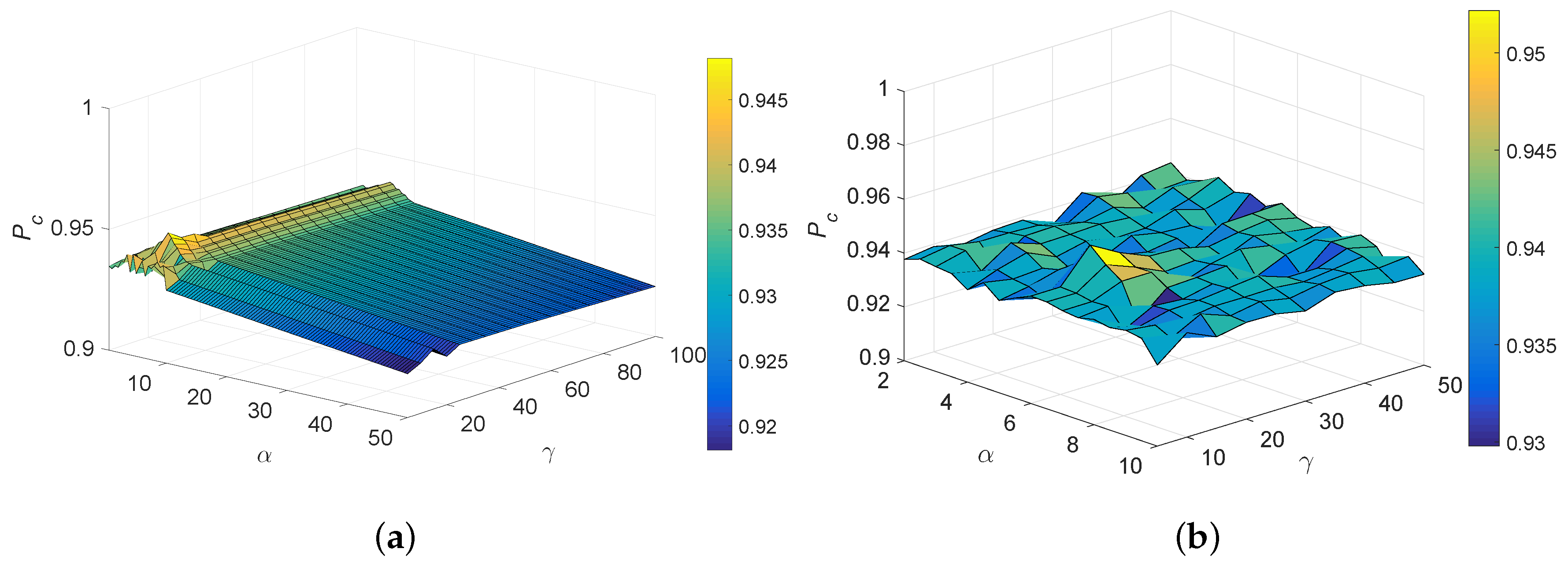
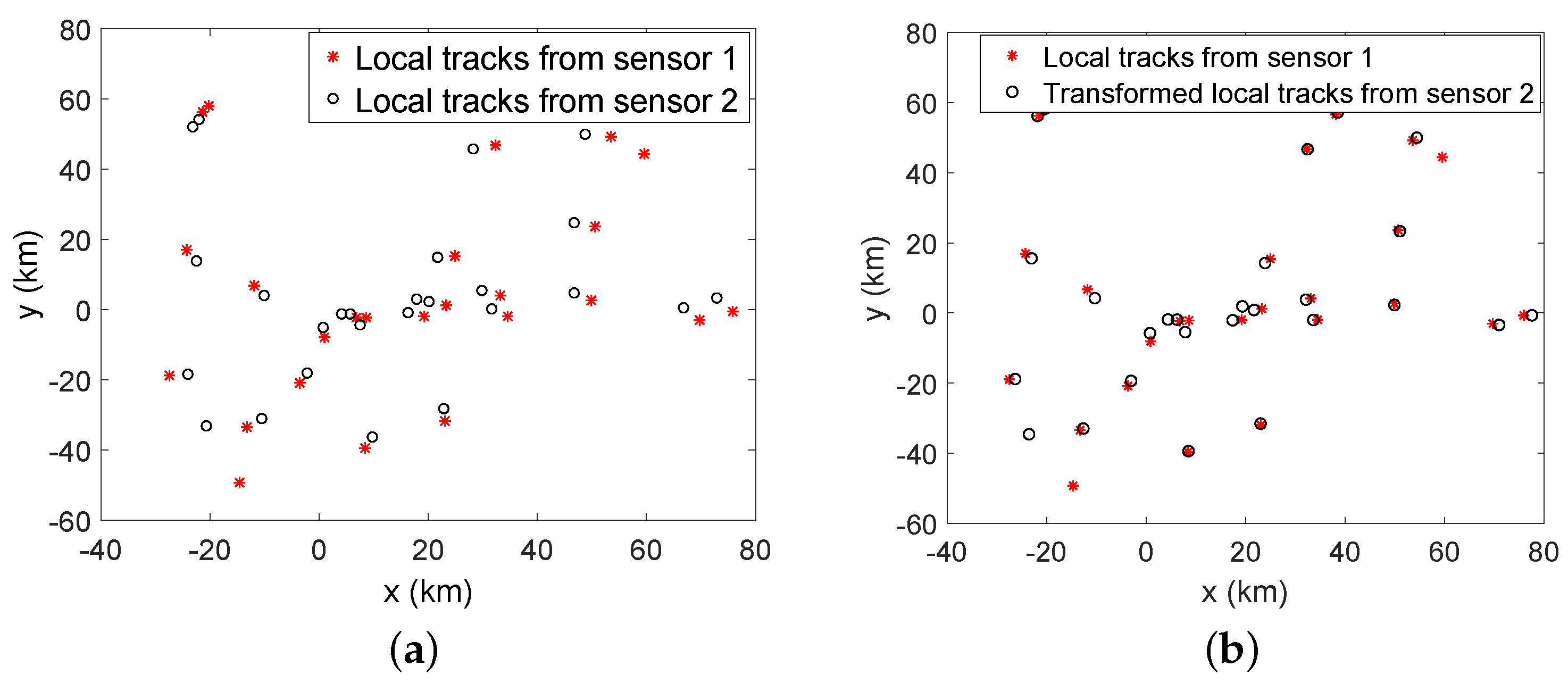
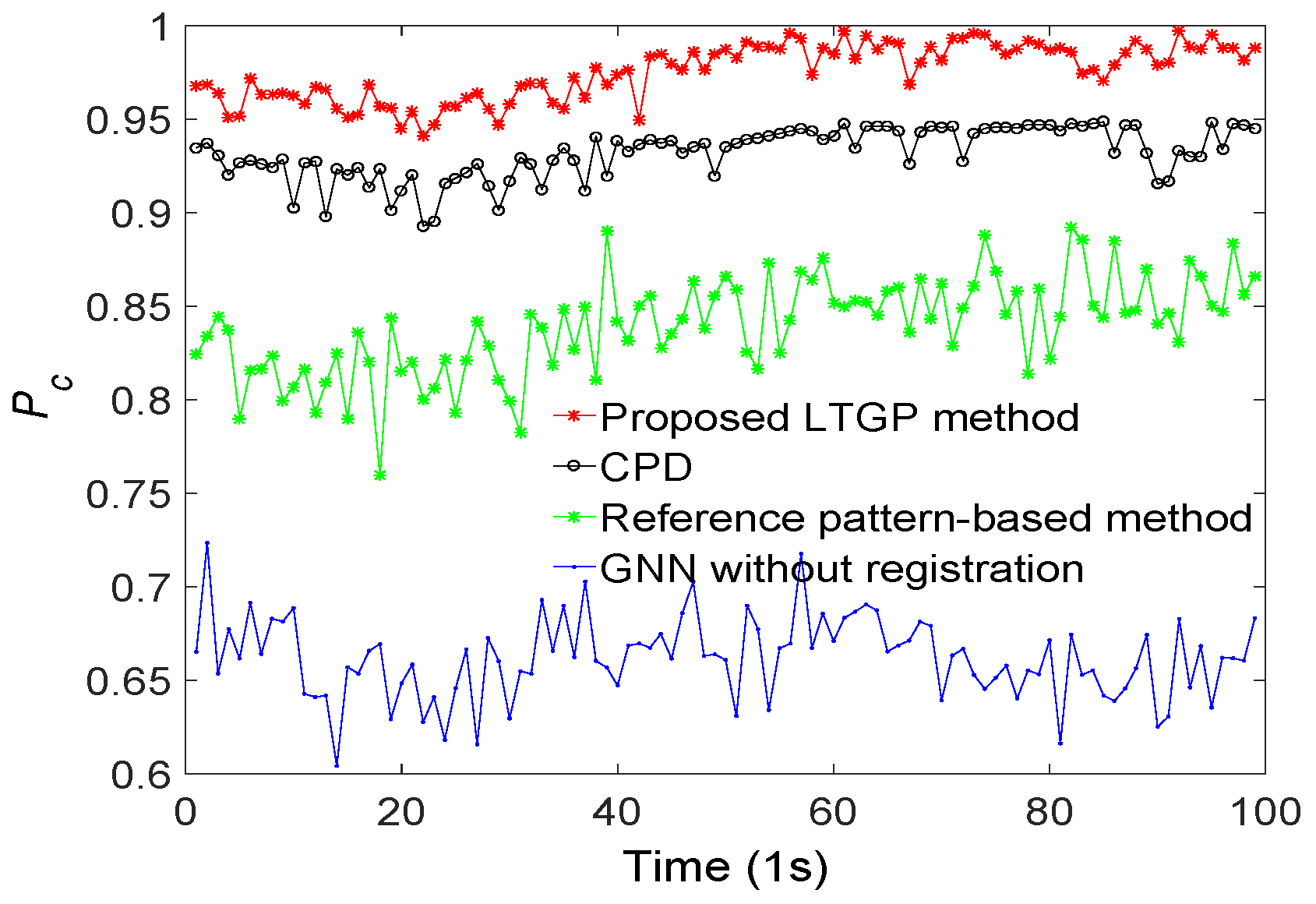
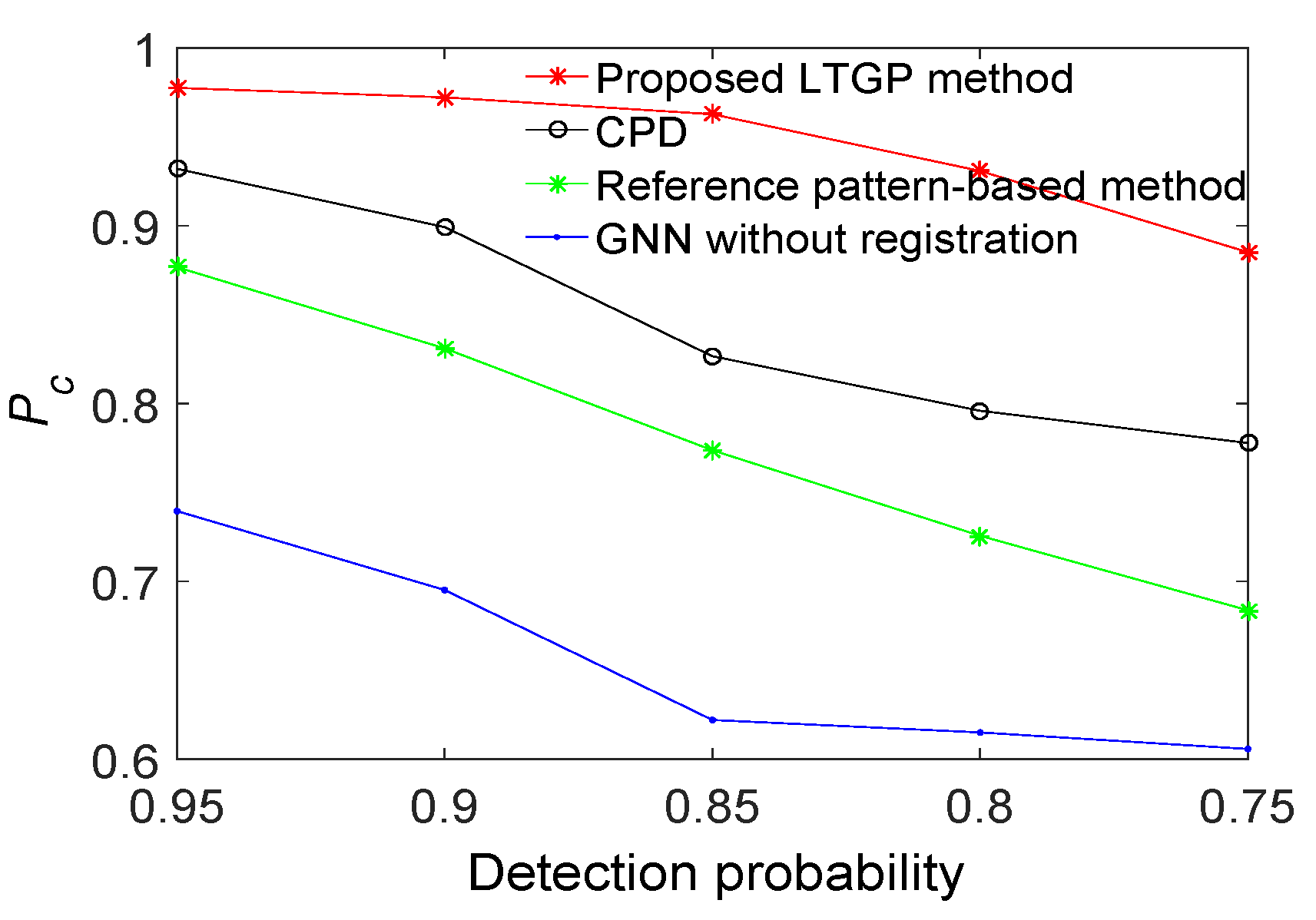
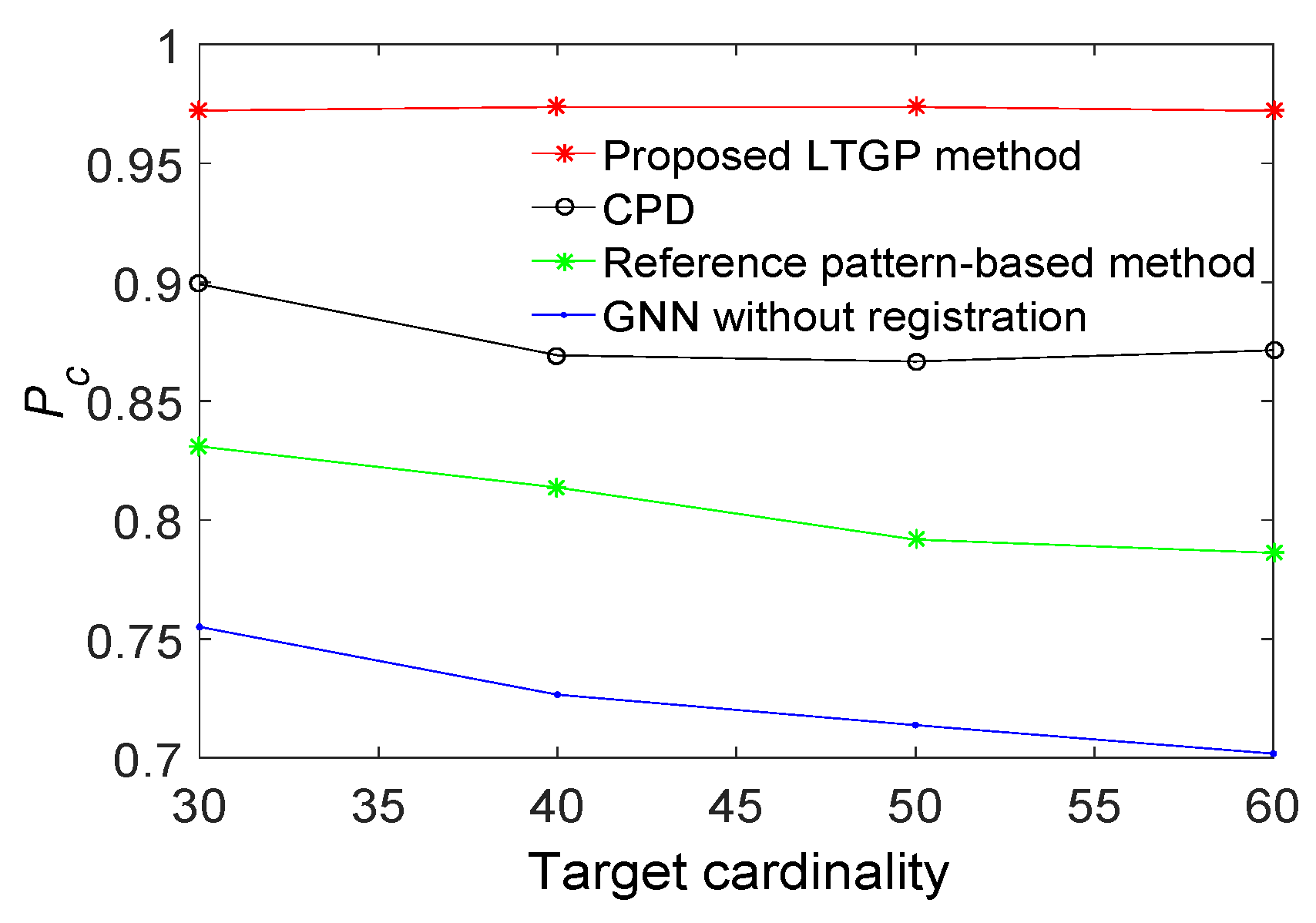

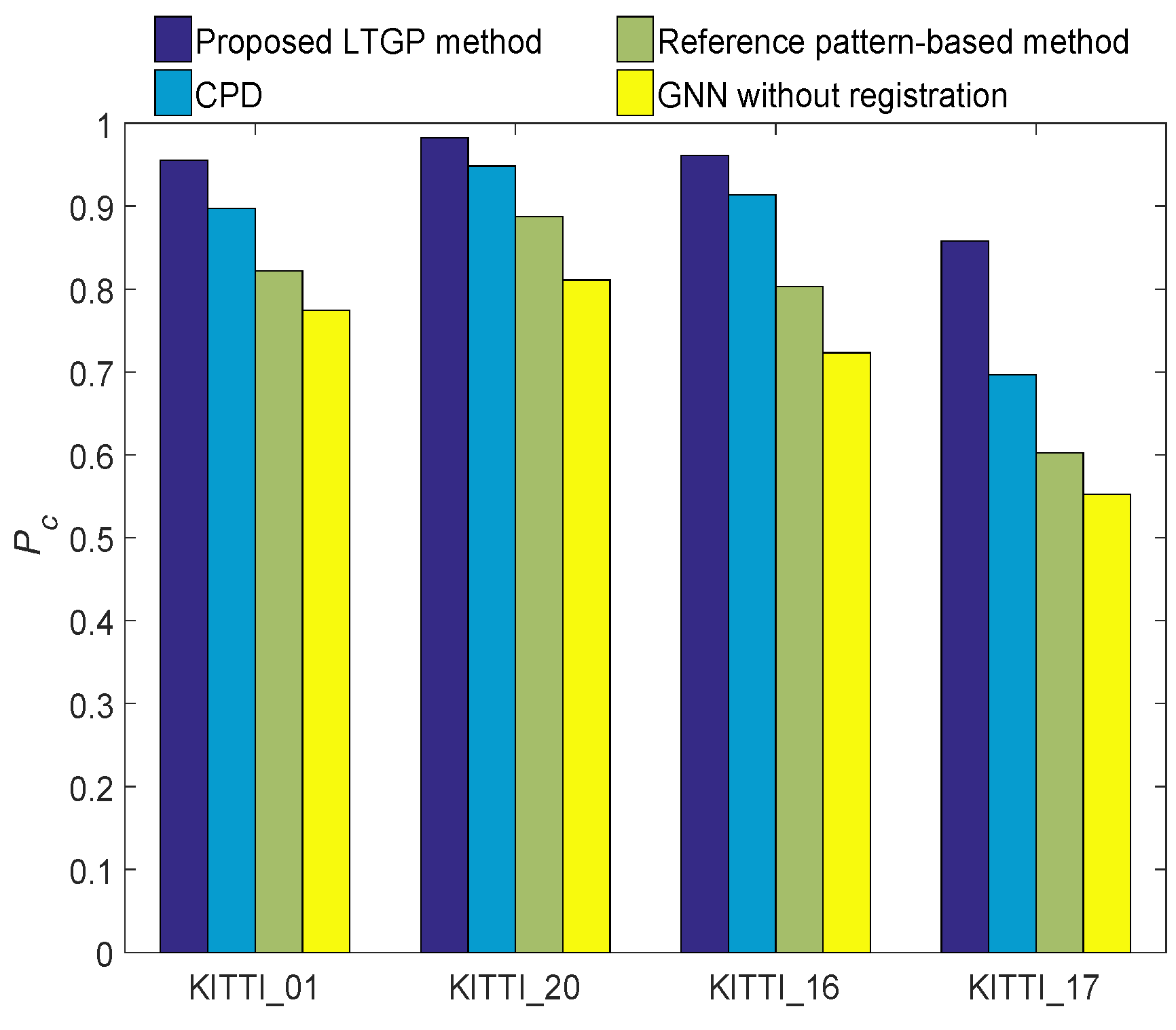
| Method | GNN without Registration (s) | Reference Pattern-Based (s) | CPD(s) | LTGP(s) | |
|---|---|---|---|---|---|
| Sequence | |||||
| KITTI_01 | 0.0004 | 0.0008 | 0.0094 | 0.0159 | |
| KITTI_20 | 0.0004 | 0.0013 | 0.0102 | 0.0169 | |
| KITTI_16 | 0.0008 | 0.0015 | 0.0111 | 0.0176 | |
| KITTI_17 | 0.0004 | 0.0009 | 0.0104 | 0.0163 | |
© 2020 by the authors. Licensee MDPI, Basel, Switzerland. This article is an open access article distributed under the terms and conditions of the Creative Commons Attribution (CC BY) license (http://creativecommons.org/licenses/by/4.0/).
Share and Cite
Zou, K.; Zhu, H.; De Freitas, A.; Li, Y.; Esmaeili Najafabadi, H. Track-to-Track Association for Intelligent Vehicles by Preserving Local Track Geometry. Sensors 2020, 20, 1412. https://doi.org/10.3390/s20051412
Zou K, Zhu H, De Freitas A, Li Y, Esmaeili Najafabadi H. Track-to-Track Association for Intelligent Vehicles by Preserving Local Track Geometry. Sensors. 2020; 20(5):1412. https://doi.org/10.3390/s20051412
Chicago/Turabian StyleZou, Ke, Hao Zhu, Allan De Freitas, Yongfu Li, and Hamid Esmaeili Najafabadi. 2020. "Track-to-Track Association for Intelligent Vehicles by Preserving Local Track Geometry" Sensors 20, no. 5: 1412. https://doi.org/10.3390/s20051412
APA StyleZou, K., Zhu, H., De Freitas, A., Li, Y., & Esmaeili Najafabadi, H. (2020). Track-to-Track Association for Intelligent Vehicles by Preserving Local Track Geometry. Sensors, 20(5), 1412. https://doi.org/10.3390/s20051412





